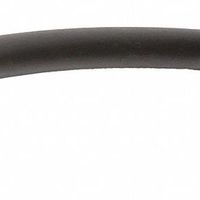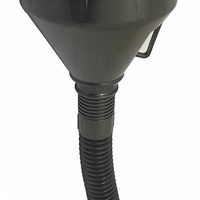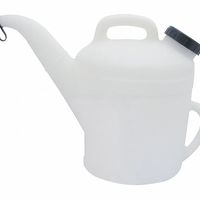Call +(254) 703 030 000 / 751 483 999 / 721 704 777
- Home
- Fleet Vehicle Maintenance
- Vehicle Tools
- Vehicle Lubricant Tools
- Vehicle Funnels Measuring Cups
Vehicle Funnels & Measuring Cups
Vehicle funnels and measuring cups allow for precise vehicle lubrication. Funnels help reduce mess and product loss when filling small reservoirs or large containers. Measuring cups mete out the exact amount of fluid for the vehicle system that needs servicing. Read Less
Frequently Asked Questions
What is the purpose of a vehicle funnel?
A vehicle funnel is a tool or device used to guide the flow of liquids into a vehicle's reservoir or tank, ensuring that the liquid is directed accurately and efficiently without spillage. The primary purpose of a vehicle funnel is to facilitate the transfer of fluids such as engine oil, coolant, transmission fluid, brake fluid, or windshield washer fluid into their respective compartments in a vehicle.
Funnels are designed to fit securely into the opening of a reservoir, providing a wide mouth for easy pouring and a narrow spout to direct the liquid precisely. This design minimizes the risk of spills, which can lead to waste, potential damage to vehicle components, or environmental contamination.
In addition to preventing spills, funnels help in maintaining cleanliness and safety in the vehicle maintenance process. By ensuring that fluids are properly directed, they reduce the likelihood of accidental contact with hot engine parts or other sensitive areas, which could cause burns or other injuries.
Funnels can also be equipped with features such as filters to remove debris from the liquid being poured, ensuring that only clean fluid enters the vehicle system. This is particularly important for maintaining the efficiency and longevity of the vehicle's engine and other components.
Overall, the purpose of a vehicle funnel is to provide a simple, effective, and safe means of transferring fluids into a vehicle, supporting proper maintenance and operation.
How do you use a measuring cup for vehicle fluids?
To use a measuring cup for vehicle fluids, follow these steps:
1. **Select the Right Measuring Cup**: Choose a measuring cup made of a material resistant to the fluid you are measuring, such as plastic or metal. Ensure it has clear measurement markings in both milliliters and ounces for accuracy.
2. **Prepare the Vehicle**: Park the vehicle on a level surface and turn off the engine. Allow the engine to cool if necessary, especially when dealing with fluids like coolant or oil.
3. **Identify the Fluid**: Determine which fluid you need to measure, such as engine oil, coolant, brake fluid, or windshield washer fluid.
4. **Access the Fluid Reservoir**: Open the hood and locate the reservoir or dipstick for the specific fluid. Refer to the vehicle’s manual if needed.
5. **Measure the Fluid**:
- For reservoirs: Remove the cap and pour the fluid into the measuring cup until you reach the desired level. Use a funnel if necessary to avoid spills.
- For dipsticks: Remove the dipstick, wipe it clean, reinsert it, and then remove it again to check the fluid level. Use the measuring cup to add fluid if the level is low.
6. **Pour the Fluid**: Carefully pour the measured fluid back into the reservoir or engine, using a funnel to prevent spills.
7. **Check Levels**: Recheck the fluid level using the dipstick or reservoir markings to ensure it is within the recommended range.
8. **Secure Everything**: Replace caps and dipsticks securely. Clean any spills immediately to prevent damage or hazards.
9. **Dispose of Waste Properly**: Dispose of any excess fluid or used materials according to local regulations.
10. **Record Maintenance**: Note the date and amount of fluid added for future reference and maintenance records.
What are the benefits of using a funnel for vehicle maintenance?
Using a funnel for vehicle maintenance offers several benefits:
1. **Precision and Control**: Funnels provide a controlled way to pour fluids, reducing the risk of spills and overflows. This precision is crucial when adding engine oil, coolant, or other fluids, ensuring the correct amount is used.
2. **Cleanliness**: By minimizing spills, funnels help maintain a clean engine bay and work area. This cleanliness prevents dirt and debris from contaminating engine components, which can lead to mechanical issues.
3. **Efficiency**: Funnels streamline the process of adding fluids, making maintenance tasks quicker and more efficient. This efficiency is particularly beneficial in professional settings where time is critical.
4. **Versatility**: Funnels come in various sizes and shapes, making them suitable for different types of vehicles and fluid reservoirs. This versatility ensures that the right funnel can be used for specific tasks, enhancing effectiveness.
5. **Safety**: By preventing spills, funnels reduce the risk of slipping on slick surfaces and minimize exposure to potentially harmful chemicals. This safety aspect is important for both amateur and professional mechanics.
6. **Cost-Effectiveness**: Preventing spills and ensuring accurate fluid levels can reduce waste and the need for additional purchases, making vehicle maintenance more cost-effective over time.
7. **Environmental Protection**: By reducing spills, funnels help prevent environmental contamination. This protection is crucial for maintaining eco-friendly practices in vehicle maintenance.
8. **Ease of Use**: Funnels are simple tools that require minimal training to use effectively, making them accessible for both novice and experienced individuals performing vehicle maintenance.
Overall, funnels are essential tools that enhance the precision, safety, and efficiency of vehicle maintenance tasks.
How do you choose the right size funnel for your vehicle?
To choose the right size funnel for your vehicle, consider the following factors:
1. **Funnel Diameter**: Match the funnel's spout diameter to the size of the vehicle's fill port. A snug fit prevents spills and ensures efficient fluid transfer.
2. **Funnel Length**: Choose a funnel with a length that allows easy access to the fill port, especially if it's in a hard-to-reach area. Longer funnels are useful for deep or awkwardly positioned fill ports.
3. **Material**: Select a funnel made from a material compatible with the fluid being transferred. Plastic funnels are suitable for most automotive fluids, while metal or chemical-resistant funnels are better for corrosive substances.
4. **Capacity**: Consider the funnel's capacity to handle the volume of fluid you need to transfer without frequent refilling. Larger funnels are ideal for transferring large quantities quickly.
5. **Design Features**: Look for features like a flexible spout for maneuverability, a built-in filter to catch debris, or a no-spill design to minimize mess.
6. **Vehicle Type**: Different vehicles may have varying fill port sizes and locations. Check your vehicle's manual for specific recommendations or measure the fill port to ensure compatibility.
7. **Purpose**: Determine the primary use of the funnel. For oil changes, a wide-mouth funnel is beneficial, while a narrow spout is better for precision tasks like adding brake fluid.
8. **Storage and Portability**: If space is limited, consider collapsible or stackable funnels for easy storage.
By evaluating these factors, you can select a funnel that fits your vehicle's needs, ensuring efficient and clean fluid transfers.
Can measuring cups be used for all types of vehicle fluids?
No, measuring cups should not be used for all types of vehicle fluids. Measuring cups are typically made of materials like plastic or glass, which may not be resistant to the chemical properties of certain vehicle fluids. Here are some considerations:
1. **Chemical Compatibility**: Vehicle fluids such as brake fluid, transmission fluid, and coolant can be corrosive or reactive with certain materials. Using a measuring cup not designed for these fluids can lead to contamination or degradation of the cup.
2. **Precision and Safety**: Measuring cups are generally not designed for the precision required in automotive applications. Incorrect measurements can lead to improper fluid levels, potentially causing vehicle malfunction or damage.
3. **Cross-Contamination**: Using the same measuring cup for different fluids can lead to cross-contamination. Even small residues of one fluid can adversely affect the performance of another, especially in sensitive systems like brakes or transmissions.
4. **Material Integrity**: Some vehicle fluids can weaken or damage the material of a standard kitchen measuring cup, leading to leaks or spills, which can be hazardous.
5. **Specialized Tools**: Automotive fluids often require specialized tools for measurement and handling. These tools are designed to withstand the chemical properties of the fluids and provide accurate measurements.
In summary, while measuring cups might be convenient, they are not suitable for all vehicle fluids due to issues of chemical compatibility, precision, and safety. It is advisable to use tools specifically designed for automotive purposes to ensure proper maintenance and safety.
What materials are best for vehicle funnels and measuring cups?
For vehicle funnels, the best materials are typically plastic, metal, and silicone. Plastic funnels, often made from high-density polyethylene (HDPE) or polypropylene, are lightweight, resistant to chemicals, and cost-effective. Metal funnels, usually made from stainless steel or aluminum, offer durability and resistance to high temperatures, making them suitable for transferring hot fluids. Silicone funnels are flexible, heat-resistant, and can be collapsed for easy storage, making them versatile for various applications.
For measuring cups used in automotive contexts, materials like plastic, stainless steel, and glass are preferred. Plastic measuring cups, made from durable polymers like HDPE or polypropylene, are lightweight, resistant to chemicals, and affordable. Stainless steel measuring cups are robust, resistant to corrosion, and can withstand high temperatures, making them ideal for precise measurements of hot or corrosive fluids. Glass measuring cups, often made from borosilicate glass, are resistant to thermal shock and provide clear visibility for accurate measurements, though they are more fragile compared to plastic and metal options.
How do you clean and maintain vehicle funnels and measuring cups?
To clean and maintain vehicle funnels and measuring cups, follow these steps:
1. **Initial Rinse**: Immediately after use, rinse the funnel and measuring cups with warm water to remove any residual fluids. This prevents the fluids from drying and becoming harder to clean.
2. **Detergent Wash**: Use a mild detergent mixed with warm water. Scrub the surfaces with a soft brush or sponge to remove any remaining residues. Pay special attention to the spout and crevices of the funnel.
3. **Rinse Thoroughly**: Rinse the items thoroughly with clean water to remove any soap residue. Ensure that all detergent is washed away to prevent contamination of future fluids.
4. **Dry Completely**: Allow the funnel and measuring cups to air dry completely. Place them upside down on a clean towel or drying rack to ensure all water drains out.
5. **Inspect for Residues**: Once dry, inspect the items for any remaining residues or stains. If necessary, repeat the cleaning process.
6. **Storage**: Store the funnel and measuring cups in a clean, dry place. Keep them covered or in a sealed container to prevent dust and dirt accumulation.
7. **Regular Maintenance**: Periodically check for cracks or damage. Replace any items that show signs of wear to prevent leaks or contamination.
8. **Avoid Cross-Contamination**: Use separate funnels and measuring cups for different fluids (e.g., oil, coolant) to avoid cross-contamination. Label them if necessary.
9. **Deep Cleaning**: Occasionally, perform a deep clean using a vinegar solution or specialized cleaning agents for stubborn residues. Rinse thoroughly afterward.
10. **Safety Precautions**: Wear gloves when handling chemicals and ensure proper ventilation during cleaning to avoid inhaling fumes.
By following these steps, you can ensure that your vehicle funnels and measuring cups remain clean, functional, and safe for use.


